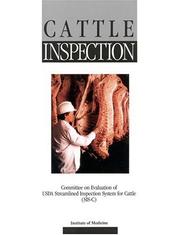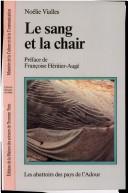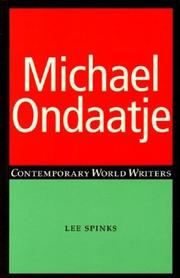| Listing 1 - 10 of 22 | << page >> |
Sort by
|
Book
Year: 2017 Publisher: [Place of publication not identified] : Great Neck Publishing,
Abstract | Keywords | Export | Availability | Bookmark
 Loading...
Loading...Choose an application
- Reference Manager
- EndNote
- RefWorks (Direct export to RefWorks)

ISBN: 030904345X 9786610211937 1280211938 0309568471 0585149070 9780585149073 9780309043458 Year: 1990 Publisher: Washington, D.C. National Academy Press
Abstract | Keywords | Export | Availability | Bookmark
 Loading...
Loading...Choose an application
- Reference Manager
- EndNote
- RefWorks (Direct export to RefWorks)
Beef --- Meat inspection --- Slaughtering and slaughter-houses --- Inspection --- Abattoirs --- Butchering --- Meat industry and trade --- Public institutions --- Meat
Book
ISBN: 1609385861 Year: 2018 Publisher: Iowa City : University of Iowa Press,
Abstract | Keywords | Export | Availability | Bookmark
 Loading...
Loading...Choose an application
- Reference Manager
- EndNote
- RefWorks (Direct export to RefWorks)
Employee rights --- Meat industry and trade --- Slaughtering and slaughter-houses --- History. --- Employees. --- Smithfield Foods, Inc. --- Employees --- Labor unions. --- Corrupt practices.

ISBN: 2735102122 9782735102129 2735118193 Year: 1987 Volume: 8 Publisher: Paris Maison des sciences de l'homme
Abstract | Keywords | Export | Availability | Bookmark
 Loading...
Loading...Choose an application
- Reference Manager
- EndNote
- RefWorks (Direct export to RefWorks)
« Vous ne pourrez manger aucune bête crevée ». Notre société reste fidèle à l'interdit du Deutéronome et tue les animaux dont elle se nourrit. Mais tout procédé de mise à mort n'est pas accepté ; il faut verser le sang pour pouvoir transformer le corps en substance consommable, en viande de « boucherie ». Or, de cette condition première du régime carné, nous ne voulons pourtant rien voir. Les sacrifices solennels, les célébrations festives, puis les tueries fonctionnant dans les villes ont fait place aujourd'hui à un abattage invisible, enclos dans des lieux appropriés, tenu à bonne distance. Cette récente séparation entre abattage et boucherie épargne à nos regards le geste fondateur du régime carné. Pourquoi donc faut-il verser le sang des bêtes pour pouvoir se nourrir de leur chair ? Et pourquoi cette nécessité offense-t-elle nos sensibilités, sans pourtant nous rendre végétariens ? En observant des abattoirs du sud-ouest de la France, Noélie Vialles, met en lumière l'existence d'un système complexe d'évitement et de dépassement du geste fatal. Son analyse montre comment les modalités de mise à mort et de préparation des animaux domestiques pour la consommation humaine mettent en jeu, bien au-delà de l'abattage, des représentations symboliques du sang, des hommes et des bêtes.
Slaughtering and slaughter-houses --- History --- #SBIB:39A72 --- #SBIB:93H3 --- -Abattoirs --- Butchering --- Meat industry and trade --- Public institutions --- Etnografie: Europa --- Thematische geschiedenis --- -Etnografie: Europa --- History. --- Abattoirs --- Slaughtering and slaughter-houses - France - History --- Anthropology --- abattoir --- viande --- bétail --- boucherie --- sociologie --- France --- ANIMAUX DE BOUCHERIE --- BETAIL --- FRANCE --- ABATTAGE --- SUD-OUEST --- HISTOIRE --- ASPECT SOCIOLOGIQUE
Book
ISBN: 9781108553544 9781108428804 9781108447317 1108428800 1108575293 1108553540 1108581633 Year: 2019 Publisher: Cambridge Cambridge University Press
Abstract | Keywords | Export | Availability | Bookmark
 Loading...
Loading...Choose an application
- Reference Manager
- EndNote
- RefWorks (Direct export to RefWorks)
In this book, Krish Seetah uses butchery as a point of departure for exploring the changing historical relationships between animal utility, symbolism, and meat consumption. Seetah brings together several bodies of literature - on meat, cut marks, craftspeople, and the role of craft in production - that have heretofore been considered in isolation from one another. Focusing on the activity inherent in butcher, he describes the history of knowledge that typifies the craft. He also provides anthropological and archaeological case studies which showcase examples of butchery practices in varied contexts that are seldom identified with zooarchaeological research. Situating the relationship between practice, practitioner, material and commodity, this imaginative study offers new insights into food production, consumption, and the craft of cuisine.
Slaughtering and slaughter-houses --- Meat industry and trade --- Meat consumption --- Packing industry --- Food industry and trade --- Abattoirs --- Butchering --- Public institutions --- History --- Animal remains (Archaeology) --- Archaeozoology --- Zooarchaeology --- Zoology in archaeology --- Archaeology --- Bones --- Animal paleopathology --- History. --- Methodology
Book
ISBN: 9789492051561 9492051567 Year: 2020 Publisher: [Breda] The Eriskay Connection
Abstract | Keywords | Export | Availability | Bookmark
 Loading...
Loading...Choose an application
- Reference Manager
- EndNote
- RefWorks (Direct export to RefWorks)
The human and the horse share a long history together. At first horses were working animals, serving as a means of transport in agriculture and in war. Nowadays, horses are domestic pets with a moral status: used for recreation, in competitions, and for medical therapy. In 1948 the grandfather of Heleen Peeters (BE) began a business in what many now consider to be taboo: horse meat. At that time, people were poor, recovering from the struggles of World War II, and horse meat, being a high quality product for an affordable price, was in high demand. But now, 70 years later, the consumption and production of horse meat is disappearing. Peeters broadly documented and investigated horse (meat) culture in Belgium, France, Italy, Poland, Argentina, Uruguay, Kyrgyzstan, the United States and Canada. Why is horse meat becoming less popular? What happens to horses if they are no longer eaten? How do we relate to animals in the first place? And what about the need to cut back on our meat consumption?
Peeters, Heleen --- Photography of horses --- Horses --- Slaughtering and slaughter-houses --- Horsemeat --- fotografie --- documentaire fotografie --- dierenfotografie --- paarden --- eenentwintigste eeuw --- België --- Peeters Heleen --- 77.071 PEETERS --- Hippophagy --- Horse meat --- Meat --- Abattoirs --- Butchering --- Meat industry and trade --- Public institutions --- Peeters, Heleen. --- Photography
Book
ISBN: 0300152671 030015268X 9786613321541 1283321548 9780300152685 9780300152678 9780300192483 0300192487 Year: 2011 Publisher: New Haven, Conn. Yale University Press
Abstract | Keywords | Export | Availability | Bookmark
 Loading...
Loading...Choose an application
- Reference Manager
- EndNote
- RefWorks (Direct export to RefWorks)
This is an account of industrialized killing from a participant's point of view. The author, political scientist Timothy Pachirat, was employed undercover for five months in a Great Plains slaughterhouse where 2,500 cattle were killed per day-one every twelve seconds. Working in the cooler as a liver hanger, in the chutes as a cattle driver, and on the kill floor as a food-safety quality-control worker, Pachirat experienced firsthand the realities of the work of killing in modern society. He uses those experiences to explore not only the slaughter industry but also how, as a society, we facilitate violent labor and hide away that which is too repugnant to contemplate.Through his vivid narrative and ethnographic approach, Pachirat brings to life massive, routine killing from the perspective of those who take part in it. He shows how surveillance and sequestration operate within the slaughterhouse and in its interactions with the community at large. He also considers how society is organized to distance and hide uncomfortable realities from view. With much to say about issues ranging from the sociology of violence and modern food production to animal rights and welfare, Every Twelve Seconds is an important and disturbing work.
Slaughtering and slaughter-houses --- Meat industry and trade --- Animal welfare --- Mechanical Engineering --- Engineering & Applied Sciences --- Industrial & Management Engineering --- Social aspects --- Pachirat, Timothy, --- Meat consumption --- Packing industry --- Abattoirs --- Butchering --- Food industry and trade --- Public institutions --- Political philosophy. Social philosophy --- Social ethics --- Animal ethology and ecology. Sociobiology --- Pachirat, Timothy, -- 1976-. --- Slaughtering and slaughter-houses -- Social aspects -- United States.. --- Meat industry and trade -- Social aspects -- United States.. --- Animal welfare -- United States.
Book
ISBN: 128160366X 9786613784353 9814401242 9789814401241 9814401226 9789814401234 9814401234 9789814401227 Year: 2012 Publisher: Hackensack, N.J. World Scientific
Abstract | Keywords | Export | Availability | Bookmark
 Loading...
Loading...Choose an application
- Reference Manager
- EndNote
- RefWorks (Direct export to RefWorks)
Information Theory and Evolution discusses the phenomenon of life, including its origin and evolution (and also human cultural evolution), against the background of thermodynamics, statistical mechanics, and information theory. Among the central themes is the seeming contradiction between the second law of thermodynamics and the high degree of order and complexity produced by living systems. This paradox has its resolution in the information content of the Gibbs free energy that enters the biosphere from outside sources, as the author will show. The role of information in human cultural evolut
Evolution (Biology) --- Information theory in biology. --- Biology --- Biomathematics --- Animal evolution --- Animals --- Biological evolution --- Darwinism --- Evolutionary biology --- Evolutionary science --- Origin of species --- Evolution --- Biological fitness --- Homoplasy --- Natural selection --- Phylogeny --- Biometry --- 675.8 --- 577.2 --- 577.2 Molecular bases of life. Molecular biology --- Molecular bases of life. Molecular biology --- 675.8 Industries based on leather and fur production wastes (including slaughter and carcass by-products). Waste collection, reprocessing, utilization --- Industries based on leather and fur production wastes (including slaughter and carcass by-products). Waste collection, reprocessing, utilization --- Biological statistics --- Biometrics (Biology) --- Biostatistics --- Statistics --- Data processing --- Statistical methods&delete& --- Statistical methods
Book
ISBN: 1618117432 1618117424 9781618117434 9781618117427 Year: 2018 Publisher: Boston, MA
Abstract | Keywords | Export | Availability | Bookmark
 Loading...
Loading...Choose an application
- Reference Manager
- EndNote
- RefWorks (Direct export to RefWorks)
This is the first study of historical attempts by animal welfare groups to ban the Jewish method of slaughter (shechita). It details cases from Australia, Canada, England, Scotland, and the United States, many for the first time, in which anti-animal cruelty groups prosecuted those engaged in shechita as part of their attempts to introduce compulsory stunning of animals before slaughter. Despite claims to the contrary, this study offers clear evidence of underlying, unrelenting antisemitic motivations in the prosecutions, and highlights the ways in which a basic idea of innate Jewish cruelty was always juxtaposed with an overtly Christian ideal of humane treatment of animals across time and borders.
Shehitah --- Livestock --- Animal rights movement --- Meat industry and trade --- Religious discrimination --- NATURE / Animal Rights. --- RELIGION / Judaism / Rituals & Practice. --- COOKING / Regional & Ethnic / Jewish & Kosher. --- Discrimination --- Meat consumption --- Packing industry --- Food industry and trade --- Social movements --- Animal husbandry --- Farm animals --- Live stock --- Stock (Animals) --- Stock and stock-breeding --- Agriculture --- Animal culture --- Animal industry --- Domestic animals --- Food animals --- Herders --- Range management --- Rangelands --- Shechita --- Shechitah --- Shehita --- Shochet --- Shohet --- Slaughtering and slaughter-houses --- Jews --- Judaism --- Stunning --- Law and legislation --- Dietary laws --- Customs and practices --- Jewish method of slaughter. --- Shechita. --- abattoirs. --- animal cruelty. --- antisemitism. --- humane societies. --- kashrut. --- shochet.

ISBN: 1781703116 1847793479 9781781703113 9781847793478 9780719066320 0719066328 9780719066337 0719066336 1847795854 Year: 2009 Publisher: Manchester Manchester University Press
Abstract | Keywords | Export | Availability | Bookmark
 Loading...
Loading...Choose an application
- Reference Manager
- EndNote
- RefWorks (Direct export to RefWorks)
Michael Ondaatje is the first comprehensive and fully up-to-date study of Ondaatje's entire oeuvre. Starting from Ondaatje's beginnings as a poet, this volume offers an intensive account of each of his major publications, including The Collected Works of Billy the Kid, Coming Through Slaughter, In The Skin of a Lion and The English Patient, drawing attention to the various contexts and intertexts that have informed his work.The book contains a broad overview of Ondaatje's career for students and readers coming to his work for the first time. It also offers an original reading of his writing wh
Ondaatje, Michael, --- Ondaatje, Michael --- Ondaatje, Philip Michael --- Criticism and interpretation. --- Literature --- Literary Studies: Fiction, Novelists & Prose Writers --- LITERARY CRITICISM / Asian / Indic --- India --- Billy the Kid. --- Coming Through Slaughter. --- English Patient. --- Michael Ondaatje. --- Skin of Lion. --- intertexts. --- poet. --- poetics of postmodernism. --- postcolonial literature. --- postcolonial theory.
| Listing 1 - 10 of 22 | << page >> |
Sort by
|

 Search
Search Feedback
Feedback About UniCat
About UniCat  Help
Help News
News